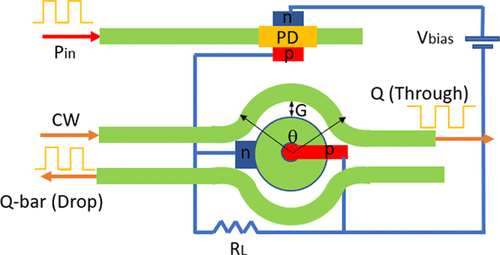当前位置:
X-MOL 学术
›
ACS Photonics
›
论文详情
Our official English website, www.x-mol.net, welcomes your
feedback! (Note: you will need to create a separate account there.)
Silicon-Based Group-IV O-E-O Devices for Gain, Logic, and Wavelength Conversion
ACS Photonics ( IF 6.5 ) Pub Date : 2020-03-06 , DOI: 10.1021/acsphotonics.9b01718 Richard Soref 1 , Francesco De Leonardis 2 , Zhoufeng Ying 3 , Vittorio M. N. Passaro 2 , Ray T. Chen 3
ACS Photonics ( IF 6.5 ) Pub Date : 2020-03-06 , DOI: 10.1021/acsphotonics.9b01718 Richard Soref 1 , Francesco De Leonardis 2 , Zhoufeng Ying 3 , Vittorio M. N. Passaro 2 , Ray T. Chen 3
Affiliation

|
Using the strip-guided “manufacturable” SOI/GeSn group-IV integrated-photonics platform operating at 1550 nm, we propose an optical-to-electrical-to-optical (O-E-O) device that can work either as an amplifierless optical repeater with gain, as a linear-optics wavelength-converter repeater, or as a new “optical–optical” logic (OOL) gate. An interconnected array of such linear-optics gates performs complicated digital-logic functions. The OEO comprises a photodetector (PD), an electro-optical modulator (EOM), and an electrical biasing-and-interconnect circuit. A digitally modulated optical signal is sent into a waveguided photoconductive GeSn PIN PD whose electrical output is compatible with the electrical input of a resonant bus-coupled Si PN-depletion microdisk EOM modulating a CW optical input beam. Our self-consistent physical model takes into account N and P doping effects. Assuming a peak optical input power of 0.5 mW and 3 V DC bias, our 1.55 μm simulations predict successful repeater-converter operation at 6.5 GHz (13 Gbit/s) and successful OOL functioning at 4.7 GHz (9.4 Gbit/s), with 12-to-16 dB extinction ratio and switching energy in the 5.8 to 9.6 fJ/bit range. A further increase of the OOL bit rate to 14 Gbit/s is available at the expense of an increased optical signal power.
中文翻译:

基于硅的IV类OEO器件,用于增益,逻辑和波长转换
利用在1550 nm下工作的带状引导的“可制造” SOI / GeSn IV组集成光子平台,我们提出了一种光电到光电(OEO)器件,该器件可以用作具有增益的无放大器光中继器,作为线性光学波长转换器中继器,或作为新的“光学-光学”逻辑(OOL)门。这种线性光学门的互连阵列执行复杂的数字逻辑功能。OEO包括光电检测器(PD),电光调制器(EOM)和电偏置和互连电路。数字调制的光信号被发送到波导的光电导GeSn PIN PD中,其电输出与调制CW光输入光束的谐振总线耦合的Si PN耗尽型微型磁盘EOM的电输入兼容。我们的自洽物理模型考虑了N和P掺杂效应。假设峰值光输入功率为0.5 mW,直流偏置电压为3 V,我们的1.55μm仿真将预测6.5 GHz(13 Gbit / s)的中继器-转换器成功运行,以及4.7 GHz(9.4 Gbit / s)的OOL成功运行,其中12 16至16 dB的消光比,开关能量在5.8至9.6 fJ / bit的范围内。将OOL比特率进一步提高到14 Gbit / s的代价是增加了光信号功率。
更新日期:2020-03-06
中文翻译:

基于硅的IV类OEO器件,用于增益,逻辑和波长转换
利用在1550 nm下工作的带状引导的“可制造” SOI / GeSn IV组集成光子平台,我们提出了一种光电到光电(OEO)器件,该器件可以用作具有增益的无放大器光中继器,作为线性光学波长转换器中继器,或作为新的“光学-光学”逻辑(OOL)门。这种线性光学门的互连阵列执行复杂的数字逻辑功能。OEO包括光电检测器(PD),电光调制器(EOM)和电偏置和互连电路。数字调制的光信号被发送到波导的光电导GeSn PIN PD中,其电输出与调制CW光输入光束的谐振总线耦合的Si PN耗尽型微型磁盘EOM的电输入兼容。我们的自洽物理模型考虑了N和P掺杂效应。假设峰值光输入功率为0.5 mW,直流偏置电压为3 V,我们的1.55μm仿真将预测6.5 GHz(13 Gbit / s)的中继器-转换器成功运行,以及4.7 GHz(9.4 Gbit / s)的OOL成功运行,其中12 16至16 dB的消光比,开关能量在5.8至9.6 fJ / bit的范围内。将OOL比特率进一步提高到14 Gbit / s的代价是增加了光信号功率。









































 京公网安备 11010802027423号
京公网安备 11010802027423号